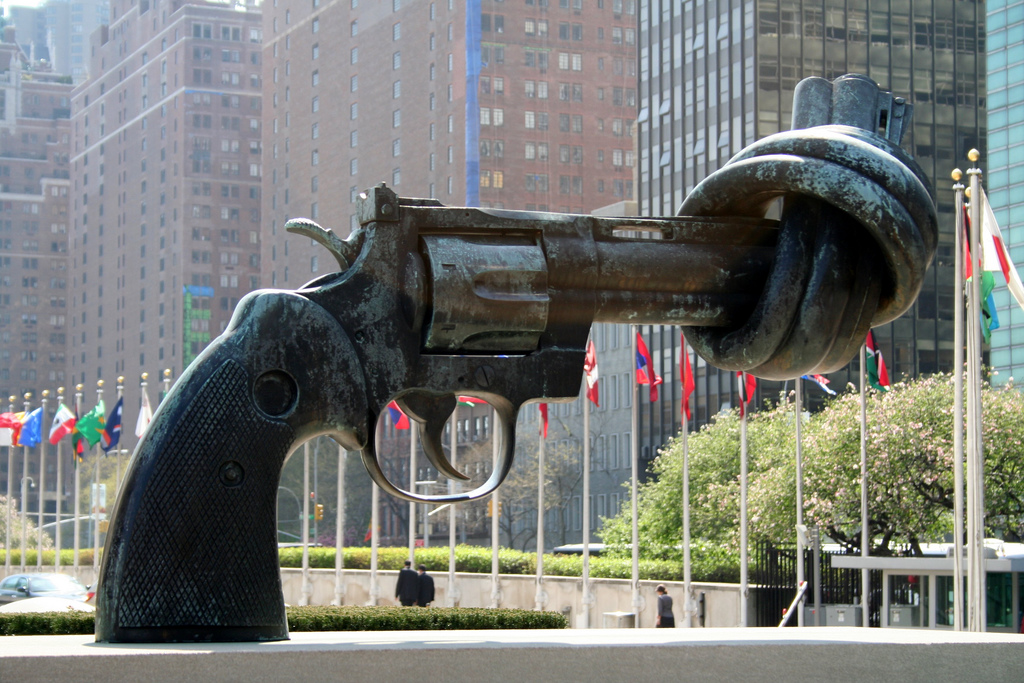In October 2016, the UN General Assembly approved a historic resolution calling for the adoption of a treaty outlawing nuclear weapons. This is something which the arms control and disarmament communities had long been pursuing. But what should the eventual treaty look like, would it result in the definitive abolition of these deadly weapons, and would a treaty banning nuclear weapons, in itself, be a good thing?
In an attempt to address some of these questions, the Bulletin of the Atomic Scientists has organised roundtable entitled ‘Can a treaty on nuclear weapons speed up their abolition?‘. The initiative is in fact a series of smaller roundtables celebrated in the first weeks of 2017, each addressing an aspect of this debate.
Nuclear disarmament is one of the pillars of the Non-Proliferation Treaty (NPT) which came into force in 1970. However, the NPT does not establish a timeline for the ‘haves’ to disarm and instead leaves them to negotiate disarmament in ‘good faith’. Many have criticised the language of the treaty for placing more emphasis on the ‘have-nots’ not developing nuclear weapon capabilities than on the ‘haves’ giving up their weapons. The emphasis, these communities claim, should be on total nuclear disarmament.
But should it? This is not self-evident, as outlined in the following paragraph extracted from an article by Polina Sinovets published on the Bulletin’s website on 26 January: “General disarmament would only advantage nations whose conventional forces are superior. (…) To be sure, one might argue that a balance in conventional arms provides deterrence between the two sides. But history shows that the reliability of conventional deterrence is dubious—while no direct evidence indicates that nuclear deterrence doesn’t work.”
Many find this a hard pill to swallow, but it is a reality that no one can deny. Eliminating nuclear weapons would leave the US as the true sole unchecked superpower, paving the way for potentially more direct interventions in non-friendly countries. It would also give India a clear edge over Pakistan and allow China – the US permitting – to camp as the undisputed hegemon in South East Asia.
But the above is missing one key point. Nuclear weapons are the harbingers of doom, as expressed by their very own creator, Robert Oppenheimer, echoing a now famous Sanscrit verse: ‘Now I am become death, the destroyer of worlds’. Nuclear deterrence is predicated upon the assumption that rational state actors will not make use of these weapons unless they face an existential threat, only comparable to the threat posed by their own nuclear arsenals.
Their defendants claim that the doctrine is so powerful that the likelihood of their intentional use is very low, as reflected in this paragraph also by Polina Sinovets: “Nuclear weapons have a fearful reputation—but conventional weaponry has caused the greatest casualties in the history of warfare. Soon after human beings created nuclear weapons, they came to understand that they stood at the brink of self-destruction, and since then they have managed to avoid using these weapons. (…) If a concept has proven useful in the past—as nuclear deterrence has done—one must proceed very carefully before discarding it.”
Again, Sinovets and others sharing the same view are missing the point, for the mere possibility that one day humans may use nuclear weapons makes nuclear deterrence the most delusional doctrine ever invented. Indeed, if nuclear weapons are at the disposal of armies and heads of state as is currently the case, no one is in a position to assure they will never be used. And what if these weapons fall into the hands of irrational actors or violent non-state actors? What about accidental use or their deployment following miscalculation of one’s opponent’s intentions? Mankind cannot allow itself to face this truly existential threat.
So where does this leave the debate? If nuclear weapons pose an existential threat to mankind but their removal risks a return to unfettered conventional warfare superiority and millions of deaths in conflict, what is there to do? The answer is as simple as complicated and, for most, utterly unrealistic: a treaty on global disarmament that encompasses both conventional and unconventional weapons with very strong verification mechanisms and an institutional framework and higher authority responsible for its correct implementation.
In a way, the foundation for such a comprehensive treaty already exists as a number of arms control and disarmament treaties and conventions have been approved in the areas of conventional, unconventional, delivery mechanisms, and confidence and security building. Add a nuclear weapons convention outlawing their existence and bring it all together in one well articulated and unambiguous comprehensive treaty, and you will get the answer. Now add political will, and we will have a solution.




























